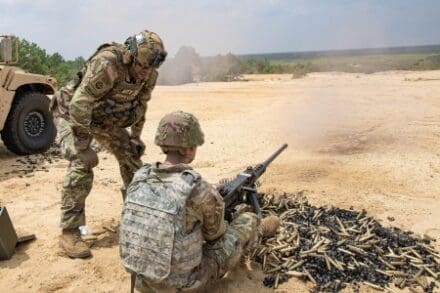FORT CARSON, Colo. — When Jacob Seitz joined the Army in April 2019, he aspired to be a Soldier that both commanders and enlisted troops could seek for battlefield knowledge.
As a master gunner for the Stryker armored fighting vehicle, Seitz joined a career field that adapts to the Army’s changing needs.
To earn the coveted Master Gunner Identification Badge [MGIB] a Soldier must take one of eight master gunner courses, such as infantry, aviation or field artillery. Required ranks range from non-commissioned officers E5 to E7 to warrant officers in aviation.
After attending the Master Gunner training in March 2023, the Army assigned Seitz as master gunner for the 1st Stryker Brigade Combat Team at Fort Carson, a position he doesn’t take lightly.
Master gunners act as tactical and technical experts for their weapons platform. They earn certifications on their assigned weapons system, ammunition and maintenance. The Army tasks master gunners with preserving the integrity of direct fire training programs.
“Everyone sees a master gunner, and they think that they can fix everything, which most of the time is true,” he said. “We do have that level of expertise. But they really look up to a master gunner to train them to a level that their squad or platoon leadership may not possess as far as knowledge or expertise to the platform.”
Seitz, a 26-year old staff sergeant, said that master gunners act as standard bearers assuring Soldiers in their platoon adhere to military doctrine. Before Soldiers can apply to attend master gunner school, they must possess intricate knowledge of their weapons system, Army range safety rules and basic weapons maintenance.
Soldiers attend the Master Gunner School at the Maneuver Center of Excellence, Fort Moore, Georgia, where they take a 20-day, four-part course known as “common core” before attending Master Gunner School. At common core, students learn how to direct fire and weapons training to raise the lethality of fires while minimizing the effects on friendly forces and bystanders. Soldiers will also learn to formulate their own mounted, machine gun unit training plan and proficiency gunnery training programs based on commanders’ intent.
Master Gunners must also consult with the S2, intelligence and security staff officer and the S3, the plans, training, and operations officer to develop battle scenarios.
“We take that information, and we do scenario development as far as collective training,” he said. “We develop scenarios based specifically on what that next fight looks like and to train our personnel on how to engage the enemy in that instance.”
Depending on the platform, some students then will attend the two-month, Master Gunner School on the tactical and technical side of their weapons platform.
“The most challenging part for the Master Gunner Course is probably the amount of memorization that you need to do on military doctrine,” Seitz said. “It’s kind of really what it’s all focused on. It’s kind of platform specific. The Stryker is arguably one of the more difficult platforms to learn.”
Seitz faced the daunting challenge of learning the Stryker’s sophisticated systems. A lighter and faster vehicle than its Bradley and tank counterparts, the Stryker has received upgrades to boost its maneuverability and lethality including variants like the Medium Caliber Weapon System.
He also took lessons on expert level doctrine of the Stryker Medium Caliber Weapon System, the anti-tank guided missile, the remote weapons station and the Javelin, a portable anti-tank weapon.
In the distinguished position, the Soldiers act as trusted counsel to commanders in battlefield scenarios.
“We serve in kind of like an advisory role, especially like in combat operations,” Seitz said. “We advise the commander based on our direct fire and indirect fire capabilities and kind of employment of our weapons systems.”
“A master gunner is a subject matter expert on their platform and the weapons system they’re in,” said Staff Sgt. Robert Sutton, a Bradley Fighting Vehicle master gunner. “Take the Bradley for example, you’re tied into [an] understanding of how the weapons systems tie into the functions of the turret; how the functions of the turret tie into the whole … as master gunners of the Bradley, we know how all this ties together.”
The Army waived a previous minimum general test score requirement for Stryker master gunners and expanded the field from cavalry scouts and infantry to include combat engineers and chemical, biological, radiological and nuclear specialists. Seitz said the service made the changes to adapt to the new Stryker variants.
The service has explored using augmented reality to enhance Soldiers training. This month the (MCoE) scheduled another Soldier touchpoint to use the Augmented Reality Maintainer-Operator Relay System or ARMORS device during master gunner training. The system uses digital work instructions and augmented reality overlays to allow students to digest lessons at a greater pace.
As the training and platform continually evolve, Seitz looks forward to using the skills he learned on the future battlefield.
“What really motivates me is my family – the Soldiers that I work with,” he said. “I leave work every day knowing that I did something to make the organization even better; a little more lethal. What I’m doing here is probably going to save lives overseas. And I know that what I do here is going to increase the number of people that come back to see their families.”
By Joe Lacdan, Army News Service


